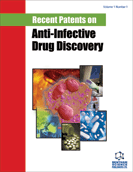Abstract
Anti-infective agents are used to treat disorders caused by bacteria, viruses, protozoa, worms, and fungi (including yeast). They are substances used on humans, animals and plants that destroy harmful microorganisms or inhibit their activity. In this mini-review, we are focusing on novel development of anti-fungal agents that have been published during the past two years. Fungi are eukaryotic microorganisms comprising over 100,000 species. Nearly 40% of all deaths from hospital-acquired infections were caused by fungi over the past 20 years. An effective anti-fungal agent is toxic to the pathogenic fungi, but not to the host. Treatment of fungi diseases, however, is often limited because antifungal agents are often toxic to the mammalian or plant host. In this review, 11 patents were chronologically and unbiasedly selected from 454 that fit the criteria out of a 4,716,037 patents search. These patents highlight the novel approaches that have been used to tackle difficult fungi. The strategies include targeting key fungal structures and metabolic pathways, developing manufacturing processes of anti-fungal reagents, unique membrane interfering fungicides, and plant and insect defensins.
Keywords: Anti-infective agent, anti-fungal, sterol biosynthesis pathway, minimum inhibition concentration, cell cycle, pyrroline-5-carboxylate reductase (P5CR, glucan synthase pathway, defensin, ATP (CTP):tRNA nucleotidyltransferase, posttranslational modification
 4
4





















